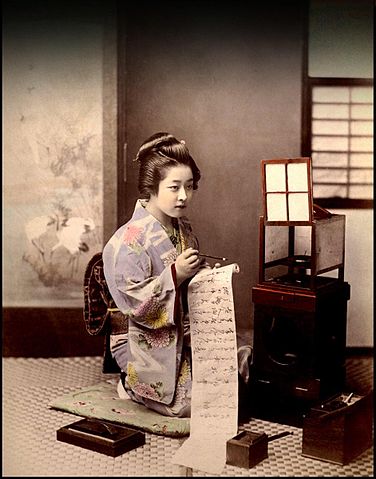How to write an abstract
People write abstracts because they are required to do so by editors or ajarns, but keep in mind that an abstract is written to be read.

The idea is that someone will look at it and decide whether or not to read your article, based on what is in the abstract. So the more compact your abstract is, the better it is, as long as you include all the major information. Using the fewest words possible shows that you respect potential readers of your work, and want to save them time. Check with the style requirements of any journal you will be submitting your article to, or ask your ajarn for the ideal length of an abstract. Generally, an abstract should not be longer than 300 words, and some are quite a bit shorter. Ask before you write.
Since an abstract is meant to be read quickly and make information easy to find, keep it to two paragraphs at most. This makes the structure of your abstract easier to plan:
- For example, you can start with a sentence or two about what past researchers have done on the same subject. When you describe the literature on the subject, whatever it is, be sure not to use more than 50 or so words.
- Follow that with the same number of words about what makes your own work special, how it is different or innovative. What does your article offer that previous articles have not? Again, do not use more than two sentences or so to describe the main points that you are adding, and no more than fifty or so words. Do regular checks under the “Review” column of your Word document for a word count to remind you that you are keeping to the suggested limits. No matter how fascinated you are with your own work, your readers will appreciate that you respect their time and keep it short.
- Next, you discuss how you carried out your research and where you found your data. This can take many words to describe, so you can go up to 150 words, especially if you used previously undiscovered or unused materials in an especially innovative way.
- What did you discover in your research? Although you may be very enthused about your findings, keep this section brief as well, around 50 words. If you absolutely need more than fifty words, then see if you can eliminate a few words from one or another of the other sections. One easy way to cut out words from any abstract is to eliminate pointless phrases like “The first part of my study is…” Readers will know what the first part of your study is, since you describe it first in your short abstract. Also, you do not need to say “this article is” or “this article will” since every reader will know already that it is an article, without your telling them. By eliminating such unneeded words, you can save a lot of space.
- Self-publicity. The final part of your abstract refutes the general rule that modesty is a virtue. If you keep telling your friends how great you are, they will soon grow very bored with you, but at the end of an abstract, it is okay and sometimes useful to say what is good or unique about your research. Readers who have very little time may not realize what you have discovered unless you tell it to them very clearly. So without boasting too much, this final section is the place to briefly say why the whole effort was worthwhile. Of course, if you are not sure about all your conclusions, do not brag that you are. While it is always better writing style to say “This is correct” instead of “This seems correct,” in case of uncertainty, you must say “seems” or “appears to be.”

If you follow the suggested structure above, your abstract should be fairly well constructed. Follow general rules about writing articles, such as never use abbreviations until you have for the first time spelled out an entire term, and then followed that with the abbreviation in parentheses. Then you may use the abbreviation and not the full term in the rest of your abstract or paper. The reason for this rule is that some abbreviations are not know everywhere in the world, and your reader will not enjoy having to Google your abbreviations to figure out what you mean by them. So the correct style would be:
The Association of Southeast Asian Nations (ASEAN) will be an important factor. ASEAN member countries will be…
Just as you must define abbreviations, always be sure to define any terms that will not be known to reasonably intelligent readers. After studying in a class, it is easy to forget that there may be readers who do not know all the specialized terminology you have learned in classwork. Once your article is published, people who see it may not have the same educational background as yourself, so be polite enough to explain unusual terms.
Pay special attention to tenses. In other words, if you start your abstract in the present or past tense, stick to that tense and do not vary, otherwise the result can be confusing to readers. In general, it is best to avoid the future tense since it can be awkward, especially when describing work you did in the past.
Since you have kept it short, there should be no reason for quotes, footnotes, or other documentation in any abstract. The whole point is that you are condensing your research by presenting it in a form without all the elements of a full research paper.
Spell-check can be your friend. Run everything you write through spell-check, although as you know, spell-check only gives suggestions, very often wrong ones. If you are in doubt about the spelling of a word, do further research or ask someone who is likely to know. Take special care to spell the names of important scholars correctly, since it only takes seconds to check this, and it is considered a sign of basic respect to spell someone’s name right.

Can you use sentences from your article/paper in your abstract? If you are a very skilled writer, it is possible that you have written a sentence short enough, and full of information, that could also be used in an abstract. Chances are that you have not, and you will probably have to further condense your words to fit the word limits of the abstract form.
Don’t dream about the future. There is no room in abstracts for suggestions about further research by other people. This can be part of your article/paper, but an abstract is only supposed to contain what you yourself accomplished in this study, not what you hope someone else may do another time.
When should you write your abstract? Most people write an abstract only when they have no choice and must do so. Certainly an abstract is usually written after almost everything else is done with a paper. That means you know more about your subject than you will probably ever know, and before you have begun to forget all about it. That is certainly a good time to write an abstract. Yet it can also be useful to write your abstract closer to the beginning of the process of writing your article or paper. Why? Because thinking about what is original in your work and the details of your approach can actually help you better understand what you are doing in your research before it is all done. You become more self-aware as an author of a paper, and the whole process of doing the paper can be more rewarding, with a higher quality result. Since an abstract is a very short text, you may decide to write one earlier in your research process, and then revise it later after you have finished all your work, in case you have more information about your findings to add. Abstracts are the kind of writing which benefit from being rewritten anyway, since it can take a couple of efforts or more to boil the text down to the required shortness. In any case, your editor or ajarn will play a decisive role in the question of when you write and submit an abstract.
Read famous scholars’ abstracts. One way to prepare for writing your own abstracts is to examine as style models the abstracts written by noted authors in your field. Check out a few articles by Nobel Prize-winners, if Nobel Prizes are given in your field of study, or equivalent high achievers. See how they manage to give an idea about what is important in their articles by what they mention – and what they leave out – of an abstract. You will notice that good abstracts assume that readers may never see the whole article, so all the essential points are mentioned in the abstract. Naturally, it is impossible to fit all the information from an article into an abstract, otherwise no one would ever write articles, only abstracts. Still, if you write a convincing enough abstract, then some readers will decide to look at your article, to find out more about what you have done and how you did it.

(all images courtesy of Wikimedia Commons).
